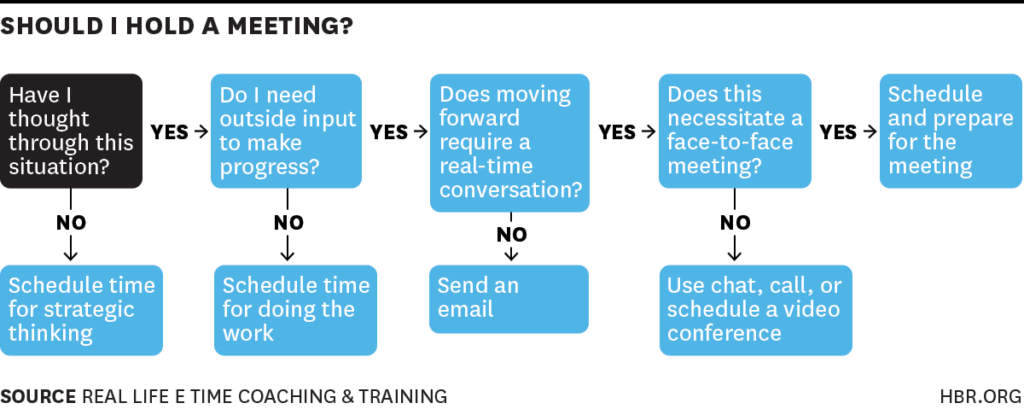To run a high-performing sales team, you need to keep them motivated.
Every level of sales team operations—including meetings—should incorporate the most common motivational factors to keep the team moving towards success.
The key drivers of motivation, as research by Hypercontext reveals, include competitive salary, fulfilling work, and a good manager.
Looking at these numbers, it’s clear that these three factors should be a top priority, especially when it comes to working towards becoming a better sales manager.
A low-hanging fruit that is often overlooked—and has the potential to improve how you lead your sales team—is how effective you are at running sales meetings.
Your sales meetings are a communication channel with the team and, like all other channels, the stakes are always high.
You need to communicate effectively and transparently to help your team members do their work in the most effective and productive way.
In this article, we’ll talk about how to run effective sales meetings to empower your team. By using these strategies, you’ll run more effective sales meetings that improve team engagement and productivity.
Table of contents
Common problems hindering your sales meetings
Meetings should leave you and the team feeling energized and looking forward to getting things done.
If you feel a loss of energy and enthusiasm every time a sales meeting ends, then there are unresolved problems getting in the way.
Before we get into how to solve them, let’s take a deeper look at the problems you’re already facing in your sales meetings.
Holding unnecessary meetings
The energy your team members need to get work done on a particular day or week is finite.
Every time you ask them to attend a meeting that could have been an update via Slack, you take up some of that energy.
Unnecessary meetings are a distraction.
They affect team productivity, which builds up to the financial cost of attending too many unnecessary meetings.

There’s also the opportunity cost that comes with unnecessary meetings.
Your team members attend meetings at the expense of getting work done, which means they have to play catch-up after every meeting, reducing the chances of hitting their KPIs.
Poor setting of agendas
Meeting agenda items need to provide clarity and set expectations for the meeting. Poor setting of agendas can involve any of the following:
- Too many agenda items: Having too many agenda items to discuss in one meeting means that your meetings run longer than necessary. Team members become distracted, and it’s likely you’ll rush through important agenda items without discussing them in enough detail.
- Too few agenda items: Meetings with few (and light) agenda items are likely to be unnecessarily short and unproductive. In such meetings, you’re likely to spend an unreasonable amount of time talking about one issue.
- Unclear agenda items: Unclear agenda items lead to sneaking in unplanned discussion topics that take up time initially allocated for the original agenda items.
For example, let’s think about a meeting with a few, unclear agenda items.
Weekly standup meetings are meant to provide updates on what team members have been working on in the past week and what they’re working on in the coming week.
There’s nothing wrong with that, as long as these updates can’t be shared via Slack or other channels.
Unfortunately, such meetings often shine the spotlight on one team member (usually the one who’s struggling to get things done), making everyone else feel out of place.
The rest of the team is likely to tune out and be resentful over being forced to meet each week, fearing they might be put on the spot in front of everyone else.
Poor facilitation
Badly run meetings, even with solid agenda items, are a waste of everyone’s time.
Think of a meeting where there is a lot of cross-talk, poor timekeeping, people leaving early, condescending tones among attendees, and unnecessary arguments.
All that ensures no progress is made by the end of the meeting.
💡 Pro tip
If you manage a sales team, you need a remote communication tool that ensures your team and client meetings run smoothly and effectively. See how other sales teams improved their collaboration with 3veta.
Lack of feedback from your team
As a sales leader, it’s easy to fall into the trap of thinking that you’re great at running effective sales meetings.
After all, we’re human and prone to positive illusions during self-assessment.
However, if you don’t collect feedback on your effectiveness in sales meetings, then chances are that you don’t know the areas in which you need to improve.
How to run an effective sales meeting?
Each meeting you run needs to help your team members get work done and improve performance engagement.
Here’s how to make sure your sales meetings are effective.
Define the goal of your sales meeting
You don’t have to hold a meeting just because you feel you should. Use this flowchart from HBR to help you decide if you need to hold that meeting in the first place:

Once you decide that you want to hold a sales meeting, think about how to manage your agenda.
It’s not quite enough to grab an agenda template, fill it up with items, and mail it to your team before the meeting.
At a basic level, having an agenda is a great step. But you need to scrutinize every item you include in your agenda and ensure it’s meaningful and worthy of everyone’s time and input.
Be clear about how the agenda items are going to push the team forward towards hitting their KPIs. Once you’re able to link the two, you’ll have laid the groundwork for an effective sales meeting.
Consult relevant stakeholders
In addition to creating an agenda on your own, talk to your team and other stakeholders to get their views on what else to include.
This process will improve your original agenda items or include items that may have escaped your attention.
For example, you may have included an agenda item related to improving team performance. A stakeholder might suggest that you narrow this down to the specifics such as defining key success metrics to avoid ambiguity.
Either way, the suggestions you receive ensure that each item aligns with company objectives.
Invite relevant attendees
Meeting rooms with too many people feel crowded.
Some team members might hide behind everyone else to avoid participating. Conversely, without the right people in the meeting, you’re likely to end up stuck and unable to thoroughly discuss what’s on the agenda.

Keep meeting sizes manageable so that everyone can participate.
Carefully think through your list of attendees when deciding on the meeting’s purpose. In a productive meeting, all team members contribute to the task at hand.
Establish expectations and conduct
Each meeting you run requires attendees to contribute—while they allow everyone else to participate without unnecessary interruptions.
Set this expectation while sharing agenda items and supporting resources beforehand so team members can prepare their talking points.
An example of a supporting resource is sales report templates to provide context and allow everyone to contribute when defining key success metrics.
When it comes to conducting, you want to make sure that there are minimal distractions.
Guidelines to govern conduct include restricting team members from leaving before the meeting ends (unless it is an emergency), banning cross-talk, getting rid of noise, making sure everyone has a proper virtual background image, and putting away mobile phones during the meeting.
Make space for collaboration to improve engagement
Encourage everyone involved in the meeting to participate by assigning roles to them during the meeting.
As a sales team leader, you’re the chair. Other roles you can delegate include timekeeper, note-taker, and facilitator.
For instance, the timekeeper ensures agenda items do not go beyond each time limit, and a note keeper notes down action points. The facilitator ensures everyone takes part in the meeting, and the chair leads everyone through the agenda.

Different people might rotate through these roles from meeting to meeting. This brings out different personalities in each meeting and keeps every remote team member engaged.
When everyone feels included, they take part in the meeting instead of passively nodding their heads in agreement (even when they have a different opinion).
Solidify your next action steps
At the end of each meeting, the note taker should provide a recap of what you’ve discussed. They should also share which team member is responsible for the next action items to make sure everyone is on the same page.
Solidifying the next steps at the end of one meeting avoids the need for another meeting later on to provide updates on discussed items.
If you’re running a large sales team, have a virtual assistant collect these updates from individual team members.
They’ll prepare a report to share with you and with the entire team via Slack or email for example.
Set constraints
Effective sales meetings need constraints.
In a 1955 essay, Northcote Parkinsonargued that work always expands to fit the amount of time you allocate to it, also known as Parkinson’s Law. The same happens when it comes to meetings.
The more time you allocate to meetings, the more things you will have to talk about. But it doesn’t necessarily mean that the meeting is effective.
To avoid falling into this trap, set constraints that keep you on your toes.
Here are a few constraints to help you get started:
Always start and end the meeting on time
Your timekeeper needs to allocate enough time to agenda items and ensure no one speaks too long.
This way, you know that the sales meeting will stay focused on the agenda items. No one will introduce a new point midway and risk running out of time.
Set a limit on the number of agenda items
Without a limit on agenda items per meeting, you end up with a varying number of meeting points to get through.
Some sales team meetings might feel intense and others might feel like a walk in the park.
Limiting the number of agenda items ensures only what needs to be on the agenda appears there. Everything else stays out.
Have a regular time and day when you meet
Meeting at the same time and day each week can seem boring, but a routine creates predictability.
Your sales team creates their schedules around the meeting, meaning it becomes part of their routine rather than an unwelcome distraction.
Ask for feedback
Every sales team is different. In addition to using the strategies above, start collecting feedback regularly from your team to identify areas of improvement.
Feedback provides an accurate picture of the terrain. It helps you know where to start when improving your meetings.

In addition to teammates reporting issues, feedback should also ask to identify what’s already working. This way, you can double down on your strengths.
With this knowledge, create a work plan that allows you to improve by keeping everyone’s considerations in mind.
When collecting feedback, make your surveys anonymous, just like you may with a customer feedback survey, to encourage your team to share their thoughts freely with you.
Run effective sales meetings with 3veta
Remote work is here to stay and the question is no longer about doing away with meetings—rather, it’s about continually assessing whether you’re running your sales meetings as effectively as you should.
3veta ensures your remote sales meetings are as effective and as productive as they can ever be.
Wanna see how 3veta can improve your sales meetings? Start your free trial today!

Shadrack Wanjohi
Shadrack Wanjohi is a B2B writer who creates content for B2B brands in the Tech and Marketing industry.



